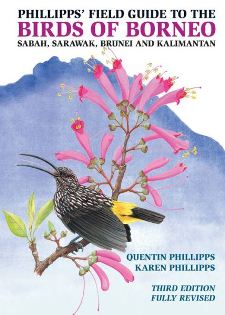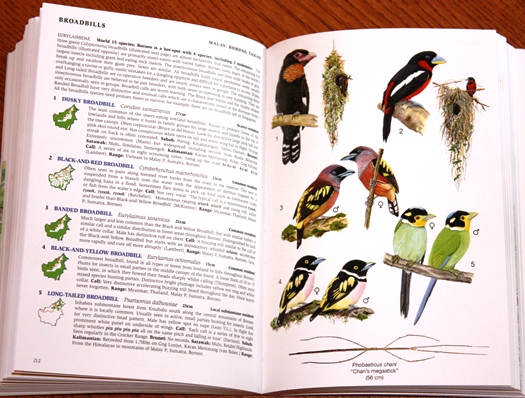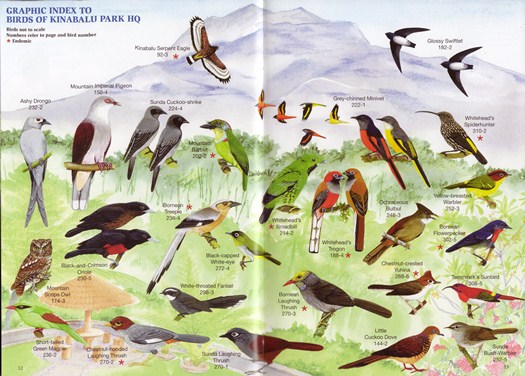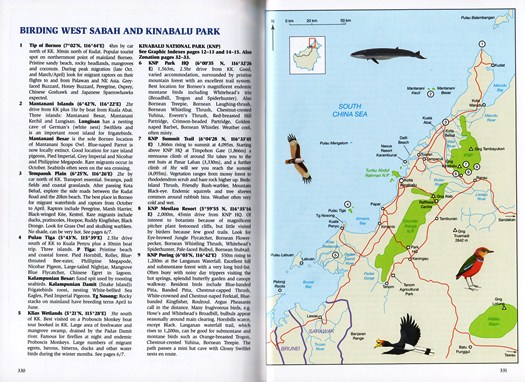Reviewed by Grant McCreary on June 22nd, 2014.
Cool, an envelope from Princeton University Press in today’s mail. Let’s see what it is…ah, a field guide to Borneo! I don’t know much about Borneo’s birds, so I think I’ll flip through it a bit. Ok, it follows the standard layout of art plates on the right-hand page, with text and range maps on the facing page. Wow, Borneo has some cool birds! The artwork looks great. Well, most of it. There’s a surprising amount of text, including some scattered sidebar text boxes.
Looks pretty good so far. Let me start back at the beginning. The inside-front cover has a visual index of bird families – that’s helpful. The next page…hmm, that’s different. Here’s a two-page “Graphic Index to Birds of the Seashore” with images from the plates superimposed over a painting of a seashore habitat. There are a total of seven of these graphic indices. Some interesting birds…woah, look at that Black-and-Red Broadbill! I’d like to see that better, so flip to the indicated page. This is one bird that I’ve got to see one day. In fact, all these broadbills look really cool. Wait, what is that on the bottom of the plate? That’s an insect! That’s right, on this bird plate there’s an illustration of a “Chan’s megastick”, some sort of (really long!) walking stick. What’s this doing here? Better read the introductory family text at the top of the facing page to see if it explains anything. Let’s see…”Borneo hosts many of the world’s largest insects including giant leaf eating stick insects. The insectivorous broadbills use their wide beaks to grip, break up and swallow their giant prey.” Neat.
Neat: that pretty much sums up my initial experience with Phillipps’ Field Guide to the Birds of Borneo. And the more time that I spend with it, the neater it becomes. I don’t normally just read a field guide. And yet, I find myself doing just that with this book. This guide has so many unconventional features that draw you in that I’m consistently intrigued and compelled to read more.
Species Accounts
The Phillipps’ guide covers 673 species, including 53 birds that haven’t even been recorded in the region yet but are likely to occur. Birders will be instantly familiar with the layout of these species accounts. The plates on the right-hand page illustrate 1-10 species each, with the average around 4-5. A good amount of variation is depicted, including both male and female as appropriate and, in fewer cases, immatures and other morphs and subspecies. The more aerial species, such as swallows, terns, nightjars, and even most shorebirds, are shown both perched/standing and in flight. Petersonian arrows are used sporadically to point out distinguishing field marks; I noticed them on eight plates. In only one case was the pointer annotated with what to look for. I wish that these arrows and annotations were used more often on the plates. My main annoyance with the plates is that the species are numbered instead of named, which means more frequent glances back and forth to tell what you’re looking at. These plates are not crowded and could easily have accommodated the more space-consuming names.
The illustrations, all but a handful of which were painted by Karen Phillipps, are very nice overall. The few birds that I’m familiar with look ok. But I find it odd, given most illustrations are by a single person, that there are distinct stylistic differences in some plates. The wagtails, for instance, are arranged in a rigid manner with all birds posed identically. But other plates have birds facing different directions or shown from different angles. For the most part, however, similar species are shown in the same poses. Also, some plates, like the migrant ducks, look less refined (for lack of a better term) to me. But none of this impairs the guide’s usefulness.
But there are other features of the plates that certainly increase the usefulness of the Phillipps’ guide. As previously mentioned, many plates show interesting things besides birds. For instance, one of the owl plates depicts two species of rats in addition to three owls. Below the illustrations is a text box on “Rats, Owls and Forest Diversity” which describes the roles of owls and rats (the owls’ primary prey) on tree species diversity in Borneo. Several plates show and label fruits that the birds of that plate feed upon. Others include extra illustrations of things like the bird at its nest or in the appropriate habitat. I’ve come to really appreciate these extras and I’ve learned a great deal by noticing them and then reading the associated text.
The text accounts begin with a header that contains the species’ English and scientific names, length, and general indicators of abundance and status. The accounts themselves are fairly long and include information on the habitat, distribution, status (like when migrants are present), identification, taxonomy (when more than one race is relevant in Borneo), vocalizations, and global range. Some specialty birds also have a list of sites where they can be found.
Only the most important features needed to distinguish the bird from similar species are mentioned, otherwise the authors let the illustrations stand alone for the purpose of identification. I would have liked to see a little more text related to ID, as I noticed several very similar-looking birds on the plates with absolutely nothing in the text regarding how to differentiate them. But I can’t argue with the text that is included; I’ve found it very informative.
The last component of the species accounts are the range maps. These have different colors for residents, endemics, migrants/non-breeding visitors, and seabirds. Thankfully, the political boundaries are shown.
Families have their own introduction that gives some general information, like how many species it has worldwide and in Borneo, nesting, and other natural history facts. These take up a good bit of room on the page, but I greatly appreciate them since I’m not familiar with many of these families.
Introduction and Other Features
The 22-page introduction includes the usual sections on bird topography and explanations of the species accounts and range maps. But, for the most part, it serves as an introduction to the ecology and conservation of Borneo’s birds. Visiting birders will appreciate the list of Borneo’s endemics (including the best locations to find them) and potential future splits.
The Phillipps’ guide includes a surprising amount of unconventional features. At the beginning of the book are seven “graphic indexes”, which are two-page spreads that illustrate one of Borneo’s habitats and its most common birds. These scenes are somewhat awkward looking, especially compared to Crossley’s photo montages, but they do a good job of showing at a glance the characteristic birds of a particular habitat and where in that habitat they are usually found.
And then at the end of the book are 22 pages devoted to birding sites. The best sites in each of Borneo’s regions are described briefly and shown on large, detailed maps. This section isn’t exhaustive or detailed enough to serve as a traveler’s only resource, but it will help narrow down places you may want to visit.
But, as they say, that’s not all. There are also over 80 “ecological and text notes” scattered throughout the guide. These sidebars discuss such things as Batesian and Mullerian mimicry, why seabirds are so scarce in Bornean waters, and Alfred Russel Wallace. I’ve had a marvelous time reading these; if I were to ever plan a trip to Borneo, I’d make sure to read each and every one. There’s a helpful index to them in the back, although some discrepancies seem to indicate that it wasn’t updated to reflect changes in this new edition.
Every time I open this guide I find another cool feature or learn something new. But perhaps the most impressive thing is that the Phillipps’ guide manages to include all these features and still be portable enough to take into the field!
Comparison to Other Guides and Previous Editions
The other primary field guide to Borneo is Susan Myers’ Birds of Borneo, published in 2009 (oddly, also by Princeton University Press). I’ve never seen that guide, but here’s a review from Jack Holloway at Avian Review.
According to the introduction, the changes in this third edition from the previous one includes four new birds added to the Borneo list, taxonomic changes (including nine new endemics resulting from splits), 15 entirely redone plates, and another 16 plates with additional or replacement art. That doesn’t sound to me like it has been “fully revised”, as advertised on the cover, so there could be additional changes in the text.
Recommendation
I really like Phillipps’ Field Guide to the Birds of Borneo. As a field guide, it should prove to be fine, although not perfect. But this is so much more than just an identification manual. Through it, birders will learn not just how to identify these birds, but a great deal about their natural history and habitats, as well as Borneo’s ecology as a whole. And it accomplishes this in a manner that doesn’t impinge on its use as a field guide. I wish more field guides would do something similar.
Disclosure: I get a small commission for purchases made through links in this post.
Buy from NHBS
(based in the U.K.)
Disclosure: The item reviewed here was a complementary review copy provided by the publisher. But the opinion expressed here is my own, it has not been influenced in any way.









Thanks for this lively and easy to read review. I’ll probably have to replace my earlier edition. 😉